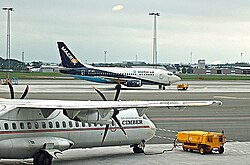Billund Airport
Billund Airport Billund Lufthavn | |||||||||||
|---|---|---|---|---|---|---|---|---|---|---|---|
 | |||||||||||
| Summary | |||||||||||
| Airport type | Public | ||||||||||
| Operator | Billund Lufthavn A/S | ||||||||||
| Location | Billund | ||||||||||
| Elevation AMSL | 247 ft / 75 m | ||||||||||
| Coordinates | 55°44′25″N 009°09′06″E / 55.74028°N 9.15167°E | ||||||||||
| Runways | |||||||||||
| |||||||||||
| Statistics (2010) | |||||||||||
| |||||||||||

Billund Airport (IATA: BLL, ICAO: EKBI) located 1 NM (1.9 km; 1.2 mi) northeast[1] of Billund, Denmark, serves as one of Denmark's busiest air cargo centers, as well as a charter airline destination, although some regular airlines also offer flights there.
The proximity of the airport to the Legoland theme park in Billund arguably makes it easier for the airport to attract passengers, and to lure more airlines into operating to the airport.
History
With the advent of the jet era, travel to Europe on the rise and such airlines as Air France, BOAC, Iberia, and United States airlines, particularly Pan Am and TWA making international advances, it was decided that an airport was needed in Billund during the 1960s. To build the airport, the Billund Airport Cooperative Society was formed, with the administrative officer of the county of Vejle, A.M. Wamberg, appointed as chairman of the board.
Assigned construction workers spent most of 1964 building the airport. On November 1 of the same year, the airport was inaugurated.
The first airline to have regular flights out of Billund Airport was SAS, with daily domestic operations to Copenhagen. The first international flight took some sailors to a ship waiting for them in Italy.
The first cargo flights began to arrive during the late 1960s. When the Boeing 747s began operating in 1970, cargo airlines from both the Americas and from Asia began to see Billund airport as a good stop-over point for their flights between the United States and the Far East, and vice-versa. Billund airport officials, seeing that the city and the airport would benefit from the extra fees that the newer carriers would have to pay for landing rights, agreed to make Billund a cargo center, and the airport's main runway was expanded in 1971, to 3,100 m (10,171 ft), enough for the largest jet of the era, the aforementioned 747, to land. Other measures, such as preparing the air tower with new technology to accommodate the new flights and busier schedule, were also taken.
Directors at Billund already envisioned non-stop, regular passenger flights to international destinations. But the European Economic Community provided a rather unlikely obstacle, preferring to have only one international airport in Denmark instead. By 1984, however, the EEC officials changed their minds, and Billund airport was finally allowed to have its first regular, non-stop airline service to another country. Maersk Air provided with the first such service, when the airline began a weekly service to Southend, England. Soon after, the famous Concorde, flown by British Airways, made a stop at the airport.
Billund became a hub airport for Maersk Air. Since then, however, the airline was bought and made a part of Sterling Airways, now Cimber Sterling, which now accounts for the most important European destinations from Billund.
With the growth of the city of Billund as a favourite destination among charter passengers, a new terminal became a necessity, and, in 2002, the airport's terminal two was opened, which allowed officials to close terminal one to passengers and turn it into a cargo-only terminal.
Capabilities
The airport handles an average of almost two million passengers a year, and millions of pounds of cargo.
The airport's main runway can handle airliners as large as the aforementioned Boeing 747, although most passengers arrive on smaller airplanes, such as ATR-42s, Boeing 737s and Boeing 757s. Boeing 747 activity at this airport is almost exclusively limited to cargo flights.
Airlines and destinations
| Airlines | Destinations |
|---|---|
| airBaltic | Riga |
| Air France | Paris-Charles de Gaulle [begins 27 March][2] |
| Atlantic Airways | Vagar |
| British Airways operated by Sun Air of Scandinavia | Brussels, Düsseldorf, Helsinki, London-City, Manchester |
| Cimber Sterling | Antalya, Bergen, Copenhagen, Dublin, Las Palmas de Gran Canaria, London-Gatwick, Málaga, Munich, Nice, Oslo-Gardermoen, Palma de Mallorca, Paris-Charles de Gaulle, Prague, Rome-Fiumicino, Stockholm-Arlanda Seasonal: Bornholm |
| Corendon Airlines | Antalya |
| DAT - Danish Air Transport | Stavanger |
| Iceland Express | Reykjavík-Keflavík |
| Icelandair | Seasonal: Reykjavík-Keflavík |
| KLM and KLM Cityhopper | Amsterdam |
| Lufthansa | Frankfurt |
| Lufthansa Regional operated by Lufthansa Cityline | Frankfurt |
| Nesma Airlines | Charter: Hurghada |
| Norwegian Air Shuttle | Oslo-Gardermoen |
| Onur Air | Charter: Antalya |
| Ryanair | Alicante, Girona, London-Stansted, Málaga, Rome-Ciampino Tenerife-South [begins 18 February], Seasonal: Alghero, Edinburgh, Faro, Malta, Milan-Orio al Serio, Palma Mallorca [begins 27 March], Pisa, Trapani |
| Sky Airlines | Antalya |
| SunExpress | Antalya |
| Transavia.com Denmark | Las Palmas de Gran Canaria, Salzburg [begins 26 December] |
Cargo airlines
Several cargo airlines (or passenger airline cargo divisions) make stops at Billund airport. Here is a partial list of cargo airlines or divisions serving Billund airport.
| Airlines | Destinations |
|---|---|
| Antonov Airlines | |
| Cargo Lion | |
| DHL | |
| FedEx Express | |
| HeavyLift Cargo Airlines | |
| KLM Cargo | |
| Lufthansa Cargo | |
| UPS Airlines | |
| Volga-Dnepr |

Ground transport
The road distance is to Billund 3 km, to Vejle 28 km, to Kolding 41 km, to Esbjerg 61 km and to Århus 98 km. There are regular buses to these cities.
See also
References
- AIP Denmark: Billund - EKBI
- VFR Flight Guide Denmark: Billund - EKBI
External links
- Billund Airport official site: Danish or English
- Current weather for EKBI at NOAA/NWS
- Accident history for BLL at Aviation Safety Network
